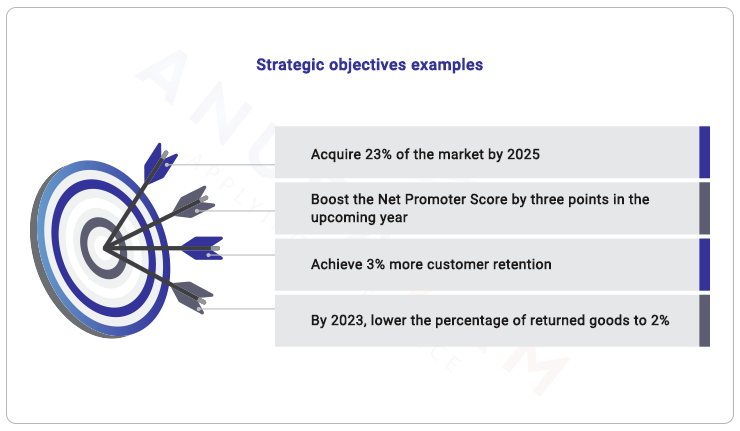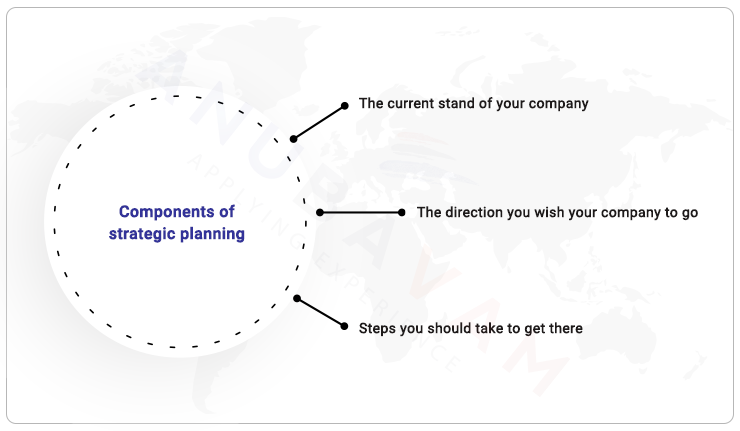Welcome to our blog on strategic planning! Strategic planning is a set of crucial initiatives for any organization that hopes to achieve long-term success. It involves outlining the organization's goals and objectives and determining the actions relevant to achieve them. The process considers internal and external factors that may impact the organization and develops a plan to address those factors.
Let us explore the different elements of strategic planning, purpose, and objectives and provide tips and insights on creating successful strategic plans for your organization. Whether you're new to the process or a seasoned pro, we hope you'll find our content relevant and informative. Thanks for reading!
What is strategic planning?
Strategic planning is the process used to outline an organization's goals and objectives and determine the actions necessary to achieve them. It involves analyzing the internal and external factors that may impact, and developing a plan to address those factors to achieve long-term success. This process typically involves the entire organization and is led by the senior management team.
What is the purpose of strategic planning?
Strategic planning helps organizations achieve their goals and objectives by outlining a clear direction for the future. It allows organizations to anticipate and adapt to changes in the business environment and make informed decisions that will drive long-term success. Additionally, strategic planning allows organizations to communicate their goals and objectives to all stakeholders, including employees, customers, partners, and investors. In short, it ensures everyone is progressing towards the same goal and promotes a shared purpose and direction.
What are strategic objectives?
The strategic objectives are comprehensive statements of intent that list all the elements that should be included and prioritized in an organizational strategy. These are definite objectives that the organization hopes to accomplish soon. These should cover an organization's core competencies and functional areas for the next three to five years.
Some of the objectives of strategic planning are listed below:
- Help in creating an operational plan
- Coordination of all work
- Establishing discipline
- Dealing with competition
- Help in inspiring employees
- Attaining organizational objectives
- Assistance with evaluation and management
- Defining the goal and the process
- Support for decision-making
- Proper resource use
- Assessing one's competitive position
Examples of strategic objectives
Here are some business examples of strategic objectives.

Top 3 essential components of strategic planning
You must gain a deeper understanding of how your business functions and where it stands with other companies in your markets if you want to develop a strategy for business growth.

You should focus on the following areas:
The current stand of your company: This requires more research about your company, including how it functions internally, what drives its profitability, and how it stacks up against rivals. Be objective, critical, and realistic.
The direction you wish your company to go: You must list your overarching goals. Create a plan for your vision, mission, values, strategies, and objectives. What do you envision for your company in five or ten years? What do you hope to establish to gain a competitive edge?
Steps you should take to get there: What adjustments will you need to make to achieve your strategic goals? How can those changes be implemented most effectively? What adjustments to your company's organization and financing are necessary, and what objectives and due dates do you need to set for yourself and other stakeholders?
Starting the process of strategic planning
Involve people: Don't try to handle everything by yourself. Look for directors, department heads, key employees, accountants, and those with analytical abilities that successful strategic planning requires.
Organize the procedure: Although there is no right or wrong way to approach strategic planning, you should be clear about your plans in advance. Everyone should be aware of their responsibilities and when they are due.
Create an accurate plan: The process has to be done correctly. Create a concrete plan without overlooking the results; it's crucial to ensure you document them in a strategic planning document or use a software tool that clarifies to everyone in your company what your top goals are. Key decision-makers, notably owners and investors, should support it.
The effective strategic goals for your business
The following traits of successful strategic goals include:
Purpose-driven
One of the most important things you should pay attention to is how your strategic goals relate to the mission and values of your organization. To better understand your organization's mission, it's necessary to ask yourself the following questions: What is your organization working toward, and why are these objectives and goals important?
Measurable
It is important to establish strategic goals and regularly track your progress toward achieving them. This will assist you in improving the tactics and strategies used by your team to achieve the goals more successfully.
Dedicated to the long term
When setting strategic goals, remember your organization's long-term goals. Never mix up operational goals with strategic goals. The latter includes regular activities and serves as a reminder of the milestones to be attained.
Strategic planning models that you can rely on
SWOT Analysis
- Using a SWOT analysis, you can determine the internal and external factors that are helpful and harmful to achieving a business goal.
- Strengths are characteristics of the company that can help it accomplish its goal.
- Weaknesses are characteristics of the company that could complicate the achievement of a goal.
- Opportunities are factors outside the goal's control that might be useful.
- Threats are external variables that could complicate the achievement of the goal.
PESTLE Tools
The following elements make up the business environment according to PESTLE:
- Political factors, such as adjustments to taxation, trade agreements, or grants for businesses
- Economic, such as changes in interest rates, inflation, and consumer demand
- Social, such as demographic shifts or altering patterns of behavior
- Technological, like the emergence of rival technologies or tools that boost your company's productivity
- Legal such as modifications to employment law or the regulations governing your industry
- Environmental, such as the shifting expectations of consumers, authorities, and employees regarding sustainable development
Five Forces model
- Businesses can determine how competitive a market is using this model. It helps;
- Customers' bargaining power - the greater it is, the more downward pressure on prices and revenue they will be able to exert
- Suppliers' bargaining power - the ability of suppliers to push prices up can have a significant impact on costs and profit
- The potential for new competitors to enter your market or industry
- With more businesses competing, it becomes worse to maintain market share and price levels.
- The risk of customers switching to more recent products and services
Guidelines for creating strategic objectives
Never be afraid to make changes. It’s never going to be smooth when you try it first. It's alright. Your Strategic Objectives may need to be written down at times to understand where the gaps are.
Engage your organization's personnel as soon as possible. Never try to handle everything yourself! Establish vision, values, and focus areas; then, use this information to structure an extensive discussion with your team about what your objectives should be. Follow the steps in this guide with your group.
Share with your team your strategic goals. Your team needs to be constantly reminded of your strategic objectives, no matter how straightforward or well-crafted they are, and they need to be constantly engaged with them. To do this, utilize a dynamic digital platform like Anubavam.
Use Anubavam’s strategy planning goal-tracking technology
Use Anubavam strategic planning software to link your team's daily work to your strategic goals rather than letting them languish in a spreadsheet or slide deck. You can keep track of short-term goals that contribute to long-term goals, delegate and track them, and instantly meet up with your team to discuss the accomplishments. Contact our team now.
Related Articles
How Personalisation in eCommerce Boosts Loyalty: Top 7 Strategies
Tune In To Our Audio Blog Today's competitive eCommerce landscape requires keeping customers engaged and converting them into loyal buyers. Personalisation in eCommerce has revolut…
Read More →How to select the right strategic planning software for your business
When it comes to purchasing strategic planning software, it is easy to become overwhelmed. There are numerous options, features, functionalities, and price points to look into. As …
Read More →Subscribe to the Creatrix Blog
Fresh insights on higher education, straight to your inbox.
We respect your privacy.
Want to contribute?
We welcome thought leaders to share ideas and write for our blog.
Become a Guest Author →
